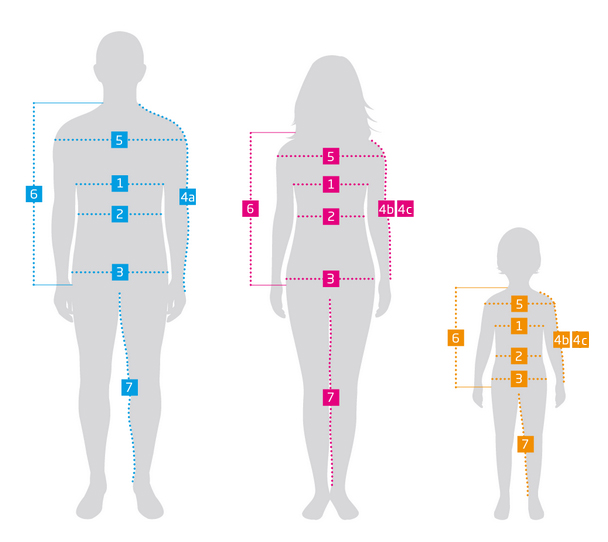Kids clothing
How to choose the right size?
The size chart shows the sizes of clothes. Please keep this in mind when deciding on the size because there’s a certain reserve between the sizes of the clothes and the sizes of the figure. The sizes in centimetres are given in ready-made EU sizes – we label clothes for men and women from XS to S, M, L up to XXXL. We mark children’s clothing with a height in centimetres.
It’s ideal to measure your favourite clothes that fit you well and compare them with the data in the size chart for a specific product. If you measure your body measurements, don’t forget to add some space for free movement. To sit comfortably, stretch your arms forward without breaking the zip fastener or a button, etc.
CAUTION! The markings by different manufacturers/brands of clothing often differ, so it may not be the case that your usual size will fit you as you are used to. It’s always a good idea to check the sizes we list for each piece of clothing. This will prevent disappointment from the purchase and save time on returning/replacing the unsuitable product.
Measurements: what and how to measure

- Chest: Measure it at the widest point across the breast. It’s most often across the nipples in women and about 2 cm under the arms in men.
- Waist: Measure it at the narrowest point of the torso.
- Hips: Measure it at the widest point across the bottom, about 20 cm below the waist. Note: For some models, we indicate the circumference of the bottom edge instead of the hips.
- Sleeve
a) Classic/head sleeve: Measure it from the top seam on the shoulder to the edge of the sleeve (from the shoulder joint to the wrist socket).
b) Raglan sleeve: Measure it from the end of the collar to the edge of the sleeve.
c) Overcut shoulders: Measure them from the end of the collar to the edge of the sleeve (up to the wrist hole). - Width of the shoulders: Measure it as the distance from the edges of the shoulder joints. Best from seam to seam on the shoulders for clothes that fit you well.
- Total length of the back: Measure it from the highest point of the collar to the bottom hem. Try to measure as vertically as possible, i.e., along the spine.
- Inside length of the pant legs: Measure it from the crotch (the highest point of the inner thigh) to the bottom edge of the legs.
.png)
RAINCOATS
- Bottom Hem
- Outer Sleeve
- Chest
- Length
CAPS
- Circumference
GLOVES, MITTENS
- Palm Width
- Palm Length
- Middle Finger
- Length

SLIM FIT = indicates tight/close-fitting clothing. Choose it if you prefer tight clothes.

REGULAR FIT = indicates our most common – classic cut. Choose it if you prefer something between a tight fit and a loose fit.

COMFORT FIT = indicates clothing in a comfortable loose fit. Choose it if you like to wear loose clothes.
General size charts
If the goods do not have their own table of sizes at the end of the photo gallery, the following general tables apply (dimensions are given in cm):
| Size | Height |
Chest |
Waist |
Hips |
| 86 | 81-86 | 49-50 | 50 | 52-53 |
| 92 | 87-92 | 51-52 | 51 | 54-55 |
| 98 | 93-98 | 53-54 | 52 | 56-57 |
| 104 | 99-104 | 55-56 | 53 | 58-60 |
| 110 | 105-110 | 57-58 | 54 | 61-63 |
| 116 | 111-116 | 59-60 | 55-56 | 64-66 |
| 122 | 117-122 | 61-63 | 57-58 | 67-69 |
| 128 | 123-128 | 64-65 | 59-60 | 70-72 |
| 134 | 129-134 | 66-67 | 61-62 | 73-75 |
| 142 | 135-140 | 68-69 | 63-64 | 76-78 |
| 146 | 141-146 | 70-73 | 65-66 | 79-81 |
| 152 | 147-152 | 74-77 | 67-68 | 82-84 |
| 158 | 153-158 | 78-81 | 69-70 | 85-88 |
| 164 | 159-164 | 82-85 | 71-72 | 89-92 |
